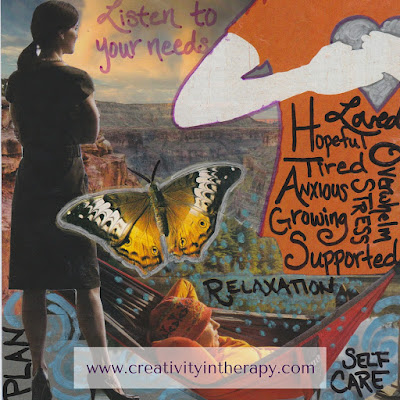
I recently got a great handout from a training, and I have been using it in a lot of my sessions as a starting point for discussion, a tool for clients to take home, and a prompt for art therapy interventions. The handout is a list of feelings and needs from www.wiseheartpdx.org and is used as part of the Non-Violent Communication method. I haven’t received more than a brief introduction to NVC, but this handout seems to be a great tool for anyone to use as a way to enhance identification and expression of feelings and needs.
A lot of people struggle with awareness and communication about their feelings. For example, for some people this may mean a denial of their distressed emotions by trying to act happy and positive all the time. Others may quickly resort to expressing anger, but fail to acknowledge all the other emotions – like hurt and disappointment – that often underlie the anger. We cannot help ourselves feel better if we don’t stop and acknowledge the emotions we are having.
Sometimes recognizing and communicating our feelings can be enough to start to feel better. However, distressed or “negative” emotions are usually the result of some unmet need. So the next step to feeling better is to identify the unmet needs and find a way to get them met. This might be by communicating them to someone else and getting help or it might be by finding a way to meet those needs for yourself.
For some clients, we might also discuss how unhealthy behaviors are an attempt to get their needs met and then discuss how they can work on meeting those needs in a more positive way.
Another helpful conversation can be to have clients choose a few of the needs from the list that feel most important to their life. Are they living a life that is meeting those needs or not? Can they make changes in their activities, career, or social connections to better meet the needs that are important to them? For teenagers, are they working towards or exploring career options that are in line with the needs that they consider most important to be fulfilled?

Feelings and needs art therapy directives:
This handout and discussion makes a great jumping off point for an art therapy activity to further explore feelings and needs. Here are a few ideas for directives to give:
1. Make a piece of art about how you are feeling today and what you are needing.
2. Make a piece of art about one unmet need in your life and the resulting feelings.
3. Make a piece of art about three of the needs that you consider most important for your life.
Who to use these directives with:
So far, I’ve done these exercise with teens and adults in individual sessions and in group therapy. The handout that I’ve linked to above is most appropriate for this age, but you could easily create a simplified version for younger children. I haven’t done this with families or couples yet, but I think it would be a great art intervention to facilitate family and partner communication. This exercise is especially helpful for clients that are having a hard time acknowledging or communicating their feelings to others or that seems really stuck in negative emotions.
For more ideas and tips about art in therapy, be sure to sign up for the newsletter: http://eepurl.com/bOu5yj

Carolyn Mehlomakulu is a Licensed Marriage and Family Therapist and Registered Art Therapist in Austin, Texas who works with children, teens, and families. For more information about individual therapy, adolescent and child counseling, family therapy, teen group therapy, and art therapy services, please visit: www.therapywithcarolyn.com.
This blog is not intended to diagnose or treat any mental health conditions. All directives, interventions, and ideas should be used by qualified individuals within the appropriate bounds of their education, training, and scope of practice. Information presented in this blog does not replace professional training in mental health, psychotherapy, counseling, art therapy, or play therapy . Although anyone can have a healing experience with art, art therapy requires the direction of a trained art therapist.
This blog includes affiliate links (see full disclosure here ). If you’d like to help support the blog without any extra cost to you, please click through on Amazon links and shop as you normally would. Your support is greatly appreciated!